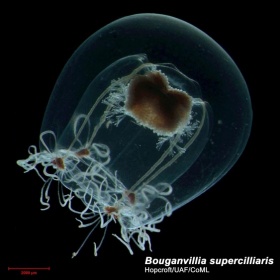Landmark 'Census of Marine Life' Culminates Today
The first-ever global Census of Marine Life will officially conclude today at a news conference in London, after a decade of marine exploration.
In one of the largest scientific collaborations ever conducted, more than 2,700 Census scientists from 80 countries spent over 9,000 days at sea on more than 540 expeditions, plus countless days in labs and archives.
Released today are maps, three books (see below), and a highlights summary that rounds out a decade of discovery.
Books:
Discoveries of the Census of Marine Life
Paul V. R. Snelgrove. Cambridge University Press, 2010.
Life in the World’s Oceans
Alasdair D. McIntyre, Editor. Blackwell Publishing Ltd., 2010.
Citizens of the Sea: Wondrous Creatures of the Census of Marine Life
Nancy Knowlton. National Geographic Society, 2010.
The Census has also prepared an extensive image gallery and video gallery, including previously unreleased images of new marine life forms.
Full background information and resources can be found on the CoML website.
The Science Media Centre held an online briefing earlier this year with Dr Mark Costello of University of Auckland, lead author of one of the final pieces of new research to emerge from the Census. A recording of that briefing and slides are available here.
New Zealand scientists who led one of the Census projects — the Global Census of Marine Life on Seamounts (CenSeam) — have provided the following comments to mark today’s announcements:
Dr Malcolm Clark, NIWA – CenSeam Principal Investigator, comments:
“Seamount research has progressed substantially in recent decades. However, despite the increased geological, oceanographic, and biological sampling of seamounts, only a small percentage of the oceans’ seamounts have been surveyed.
“Every time we put down a camera or a small net on a seamount, we see different animals, many of which are new to science.
“CenSeam has provided a lot of good science to inform, and hopefully improve, the management of commercial fisheries and mining …for example we have developed a seamount classification scheme which can help environmental managers include representative seamounts in network of marine protected areas.
“Commercial trawl fisheries are a major threat to seamount communities. We have quantified the extent of the vulnerability, and risk to seamount benthic communities from fishing…and identified the most at risk areas as concentrated in the South Atlantic, Southern Indian, South Pacific, and North Atlantic Oceans.
“There is growing evidence of the impact that bottom trawling has on seamount communities. Recovery of the seafloor communities is very slow. Our research has shown very little change even 10 years after fishing has stopped.”
Dr Ashley Rowden, NIWA – CenSeam Principal Investigator, comments:
“Censeam researchers have produced results that have challenged some of the reigning paradigms in seamount ecology. Seamounts do not appear to have such distinctly different seabed communities as was previously thought. Endemism is not particularly high, nor are most seamounts island-like in nature.
“Our research has confirmed that seamounts can be productivity hotspots in the ocean, where communities can be abundant and have high biomass compared to other deep-sea habitats.
“My personal highlights during CenSeam have been seeing New Zealand science make such a significant contribution to a global endeavour, and watching the myriad of animals materialize into view on the video coming directly from the camera flying over seamounts at the furthest reaches of and beyond New Zealand’s EEZ”
“There is still a lot of seamount research to do, but we’ve made a decent contribution and I’m looking forward to seeing our work be used by environmental managers.”
Dr Mireille Consalvey, NIWA – CenSeam Programme Coordinator, comments:
“We estimate that there may be up to 100 000 seamounts in the world’s oceans, less than 300 have been studied in enough detail to describe adequately what lives on them.
“The discoveries of communities of animals never before seen has helped fill in another piece of the jigsaw, and research on New Zealand’s seamounts has made a significant contribution to our global understanding of seamount ecosystems”
Highlights for me of CenSeam included experiencing 15m swells, which certainly demonstrated how hard ship based research can be….not to mention the risks of sending equipment down to depths in excess of a kilometre.
“Of course, whilst 2010 marks the end of the very first Census of Marine Life, really this is only the beginning….”
Background information on CenSeam
CenSeam (a Global Census of Marine Life on Seamounts) is a network of more than 500 scientists, policy makers and conservationists from around the world who have increased our understanding of what factors drive seamount community composition and diversity, such that we can better understand and ameliorate the effects of human activities.
Scientific discoveries:
- Challenging conventional wisdom: CenSeam researchers have shown that contrary to what is often stated relatively few seamounts are island-like
- Seamount community composition has been shown to be similar to surrounding habitats; however, community structure can be different
- Seamounts can support a higher benthic biomass than surrounding habitats
- Species and communities new to science; most voyages have returned undescribed species and/or expanded the range maps of faunal distribution
- For the first time the extent of the vulnerability, and risk to seamount benthic communities from fishing, has been quantified
- Whilst long cited, CenSeam researchers have demonstrated that seamount communities are disturbed by fishing and are slow to recover
- Seamounts might act as repositories of biodiversity during future periods of extreme environmental change, as they have likely done in the past
Products:
- Major book synthesising seamount knowledge at the start of CenSeam
- Major review of key scientific issues concerning the structure and function of seamount benthic communities, human impacts, and seamount management and conservation
- Open access Special Issue with Marine Ecology showcasing the latest scientific findings facilitated by CenSeam and updating the status of the various seamount paradigms, and guiding the way for future research
- Hundreds of publications across scientific and public print including a collaborative special Issue in Oceanography: Mountains in the Sea (with the Seamount Biogeosciences Network)
- Reviews, reports, and advice for end-users including the United Nations Environment Programme, International Seabed Authority, Convention on Biological Diversity, Regional Fisheries Management Organisations
- Protocols manuals and guides to facilitate standardisation of methodology (including a new book with Wiley Blackwell: Biological Sampling in the Deep-Sea due to be published 2011)
- Central database of global seamount data (5500 taxa from 258 seamounts) to support research and management
Societal impacts:
- Fostered collaborative research to expand global seamount sampling to previously uncharted regions e.g. South Atlantic, Indian Ocean
- Synthesized and analyzed existing data to shape a new set of seamount paradigms
- Increased public awareness of seamounts and the wider deep-sea; for example through sharing the experiences of researchers at sea through interactive web blogs
- Provided quality science to inform the management of commercial fisheries and mining e.g. seamount classification scheme, maps of predicted coral habitat suitability








